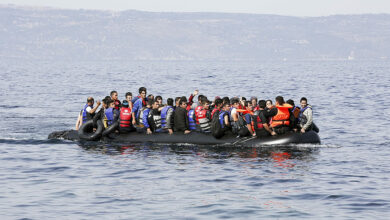IOM: 3,000 dead in 2023, nearly 100 dead or missing in first month of 2024 in Mediterranean Sea

The International Organization for Migration (IOM) recently announced that almost 100 people have died or gone missing in the Mediterranean since the beginning of this year (2024).
This comes despite the fact that European countries have enacted strict laws in recent years to prevent the entry of asylum seekers into these countries.
More details in the following report:
According to official data, the annual number of migrant deaths and disappearances in the entire Mediterranean increased from 2,048 in 2021, to 2,411 in 2022 and to 3,041 by the end of 2023.
According to a statement by the International Organization for Migration (IOM), the January death toll is twice as high as the number for the same period in 2023, which was the deadliest year for migrants at sea in Europe since 2016.
“Even one death is one too many. The latest record of deaths and disappearances is a stark reminder that a comprehensive approach that includes safe and regular pathways – a key strategic pillar for IOM – is the only solution that will benefit migrants and states alike,” Amy Pope, the director general of IOM, said.
Meanwhile, European countries have enacted strict laws in recent years to prevent asylum seekers from entering these countries.
Recently, the British government announced that despite the opposition of human rights organizations, it will deport immigrants who entered this country illegally to the African country of Rwanda.
Earlier, the European Union’s interior ministers agreed to a plan to revise the immigration and asylum policies of the Union.
This plan, which must be approved by the European Parliament in order to be implemented, has been presented against a backdrop of significant increase in the number of people entering Europe by boat through the Mediterranean Sea in 2023.
According to EU officials, thousands of people drown in the Mediterranean Sea every year during their journey to reach Europe.
The new policies include a fairer distribution of migrants and refugees across EU member states to reduce pressure on countries such as Italy and Greece, where most human-trafficking boats go.
EU interior ministers also agreed to speed up the processing and deportation of people who do not qualify for asylum.
EU ministers have agreed during a recent meeting that the countries which refuse to accept asylum seekers will be required to pay 21 thousand dollars to cover the costs of each asylum seeker in other parts of the European Union.
In 2018, the leaders of the 28 EU member states agreed on measures to solve the migration crisis, including:
Strengthening border control beyond the borders of the EU, with more financial aid to Turkey and the North African countries from which asylum seekers often leave for Europe.
Investigating the possibility of “regional landing platforms” for examining asylum applications from outside the borders of the European Union in order to neutralize human trafficking gangs.
Increasing investment in Africa to help the continent to achieve “socio-economic transformation” so that the people of this continent will no longer want to leave for a better life in Europe.




